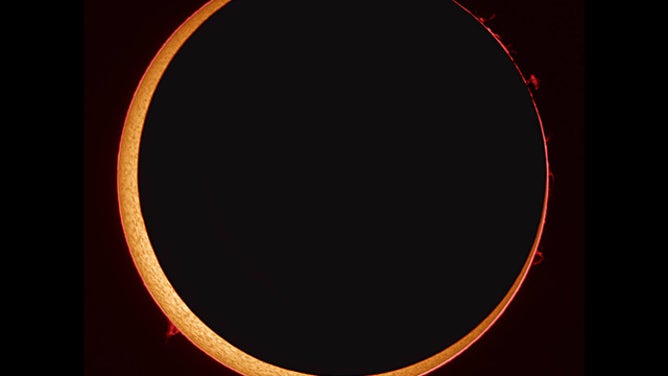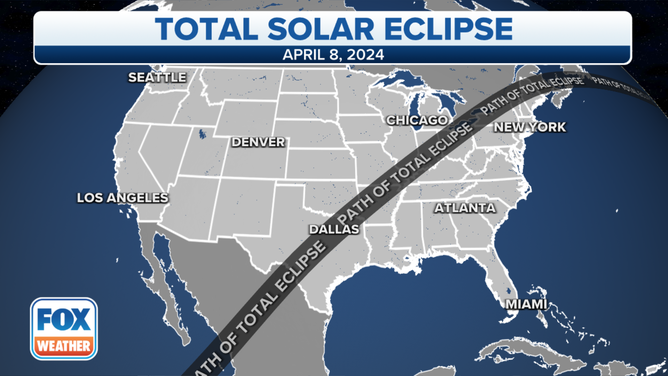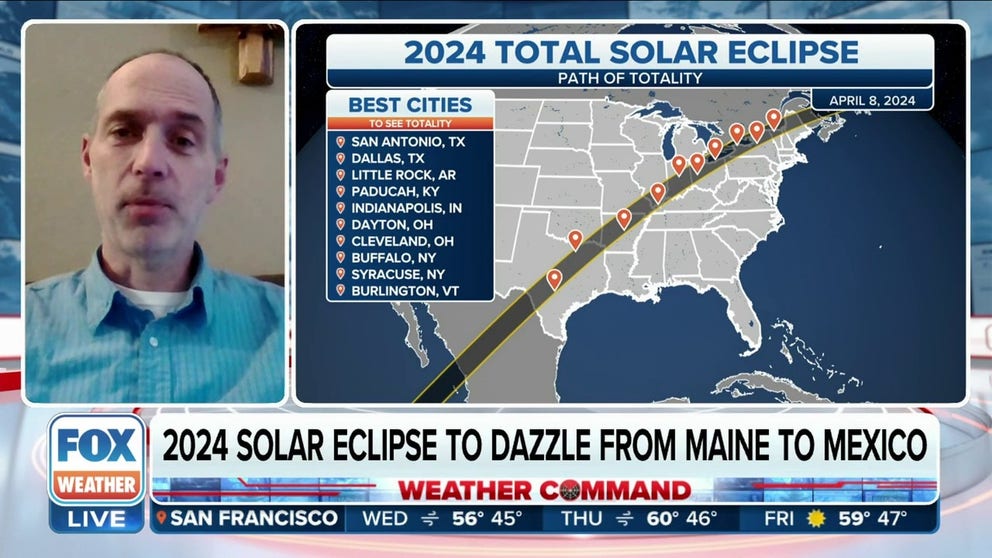NASA picks 5 experiments to fund that will study 2024 total eclipse in US
The total solar eclipse will provide a unique opportunity to study the Sun, as the Sun’s wispy outer atmosphere – known as its corona – is more clearly seen when the Moon blocks out the face of the star.
2024 Solar Eclipse to dazzle from Maine to Mexico
366 days from today a total solar eclipse will move from the Southwest to the Northeast across the Contiguous U.S. Brian Brettschneider, Climate Scientist at NWS Alaska Region, talks about the best spots to view the solar eclipse.
Five science projects will study the Sun and its influence on Earth during the total solar eclipse on April 8, 2024, NASA announced Tuesday.
The total solar eclipse will provide a unique opportunity to study the Sun, as the Sun’s wispy outer atmosphere – known as its corona – is more clearly seen when the Moon blocks out the face of the star, NASA said.

Solar eclipse.
(Stefan Seip / NASA)
Additionally, total solar eclipses can be quite rare. While solar eclipses happen about twice a year, the American Astronomical Society says darkness from a total solar eclipse for any point on the planet only happens once every 400 years.
The five NASA-funded projects taking advantage of this rare event on April 8 will study the Sun and its influence on Earth. As the eclipse will only last a few minutes, each project has a small window of time to conduct their experiments.
COUNTDOWN IS ON FOR THE GREAT NORTH AMERICAN SOLAR ECLIPSE

Path of totality during the Great North American Solar Eclipse on April 8, 2024.
(FOX Weather)
Here are the five projects:
Chasing the Eclipse with NASA’s High-Altitude Research Planes
One project will use NASA’s WB-57 high-altitude research aircraft to capture images of the eclipse from above the Earth’s atmosphere. At this altitude, the team hopes to be able to see new details of structures in the middle and lower corona. The project is led by Amir Caspi at the Southwest Research Institute in Boulder, Colorado.
Airborne Imaging and Spectroscopic Observations of the Corona
Another project will utilize the WB-57 aircraft to learn about the temperature and chemical composition of the corona and coronal mass ejections, or large bursts of solar material. The team hopes to gain new insights into the corona and the sources of solar wind. The team is led by Shadia Habbal of the University of Hawaii.

A WB-57F jet is readied for a test run at NASA’s Johnson Space Center in Houston.
(Norah Moran / NASA)
‘Listening Party’ for Amateur Radio Operators
One project tests the impact of a total solar eclipse on radio communications.
Radio communications are affected during eclipses, when the Moon’s position in front of the Sun blocks particles that impact the upper region of our atmosphere, where radio communications travel.
To learn about its impact, ham radio operators from different locations are asked to make as many radio contacts as possible during the eclipse. This project is led by Nathaniel Frissell of the University of Scranton in Pennsylvania.
Solar Radiation’s Effects on Earth’s Upper Atmosphere Layers
One experiment will study the impact of solar radiation on upper layers of the Earth’s atmosphere during the eclipse.
The team will utilize three Super Dual Auroral Radar Network (SuperDARN) radars to gather data on this during the eclipse. The project is led by Bharat Kunduri of the Virginia Polytechnic Institute & State University.
Bringing the Sun’s Magnetic ‘Hot Spots’ Into Sharper Focus
Another project will observe solar "active regions," or magnetically complex regions that form over sunspots, as the Moon moves over them during the eclipse.
The team will use a 34-meter Goldstone Apple Valley Radio Telescope (GAVRT) to measure subtle changes to the radio emissions from those active regions. The project is led by Thangasamy Velusamy of NASA’s Jet Propulsion Laboratory.
The event in 2024 will take place during the afternoon as the eclipse will travel over Mexico, into Texas and 14 other states before exiting through Canada.
San Antonio, Dallas, Indianapolis, Cleveland and Buffalo are among the places inside the path of totality.
